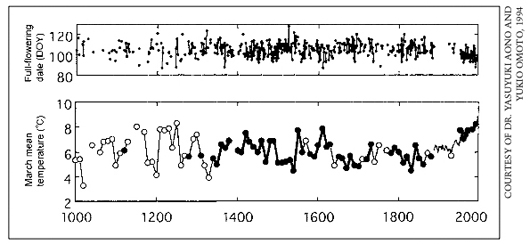Have we all got a list in us?
09.02.10 by Dan Ryan
 It's often said that we've all got a book inside us just waiting to be unleashed onto the world, but perhaps we should start with something smaller. Like a list.
It's often said that we've all got a book inside us just waiting to be unleashed onto the world, but perhaps we should start with something smaller. Like a list.
Lists can be really important pieces of data if they are accurately maintained and it's nice to be able to mobilise some hidden compulsive behaviour for the greater good. So instead of spending this spring organising your bookcases by colour, date or genre, simply grab a pen and paper and start writing things down.
In the so-called "Climategate" fiasco we've probably all come across the word "proxy". Proxies are devices that can help model the climate of the past and in "Climategate" the offending articles were predominantly tree rings. The assumption being that by looking at selected tree rings of the past scientists could infer the historic temperatures when we weren't blessed with instrumental data.
Part of the problem with using tree rings as a proxy is that it somewhat denies other biotic or abiotic factors and their possible influence on tree growth. This is also true of many other proxies used in climate research, such as coral growth, but they can give us a useful guide... but only if used properly.
But rather than looking to the past we can get much more deeply involved in the present. And with news that earlier springs could destroy the delicate balance of UK wildlife there's no better time to try and find some of this stuff out for yourself.
I first became fascinated by lists when I listened to Prof. Tim Sparks talk at the 2009 Botanic Garden Education Network conference in Ness Botanic Gardens, Liverpool. Importantly he made me realise it didn't just have to be a list. I could take photos too! In fact Sparks has been taking a photo of the same oak tree in early December every year for over 20 years. Although this is hardly statistically significant stuff the tree was so wildly different every year that over time, and presuming his will holds strong, this one tree will provide an interesting record of leaf drop and bud-burst in the spring. These minute difference in timings may seem insignificant but can have huge consequences for the wider ecology of the tree including its herbivorous inhabitants, such as caterpillars, which are preyed upon by woodland birds.
Probably the most complete list of flowering times that we know of is that of Sakura (cherry blossom) in Japan that is closely tied in with ancient festivals stretching back to the 8th century and beyond. Perhaps the most interesting thing about this list is that the flowering time seems to be getting earlier in recent decades, coinciding with recent warmer decades, on average, than at any time in past 1,000 years. The problem with data sets like this, especially as these figures are from Kyoto, may be a lack of accounting for any urban heat island effect in recent decades. However, if they include rural areas too, so the margin of error could be reduced. Either way, they certainly provide a fascinating talking point and show that if you do take up list-making you are becoming part of a long history of similarly like-minded souls.

Known dates of the cherry blossom festival (full flowering of P. jamasakura) in Kyoto from the 11th century to the present day. The bottom chart shows the estimated March mean temperature in each decade as calculated from flowering data.
Dr. Yasuyuki Anoto & Yuki Omoto, 1994
The science of list-keeping or, more properly, the timing of natural events is called phenology and happily it's a tract of science that every single one of us can get involved in. It really helps if you have daily access to a certain site to make sure you don't miss the event you're interested in and happily this fine art is being main-streamed by mass-media events such as the BBC's Springwatch and Autumnwatch programmes, which can give us an immediate outlet for our closeted personal geekery.
So take your pick! Will it be snowdrops, daffodils, swallows, the first oak leaf, primrose flower, or cuckoo. Perhaps, it will be something more wacky? As the sun begins to wake the ground up after the northern hemisphere winter, it's the perfect time to start your list and your chance to play a role in climate change science.
Related links:
UK: A comeback 60 years in the making
06.11.09
 Plantlife tell us of new hope for a rare plant - lost since World War II. Starved Wood-sedge (Carex depauperata) – a delicate grass-like plant with tall flowering stems - is one of Britain’s rarest plants, currently found in only two locations in Surrey and Somerset.
Plantlife tell us of new hope for a rare plant - lost since World War II. Starved Wood-sedge (Carex depauperata) – a delicate grass-like plant with tall flowering stems - is one of Britain’s rarest plants, currently found in only two locations in Surrey and Somerset.
UK: 2009 is a good vintage for Britain's rarest plants
01.09.09
The wild plant conservation charity, Plantlife, report that 2009 has been a great year for Britain's rarest plants.